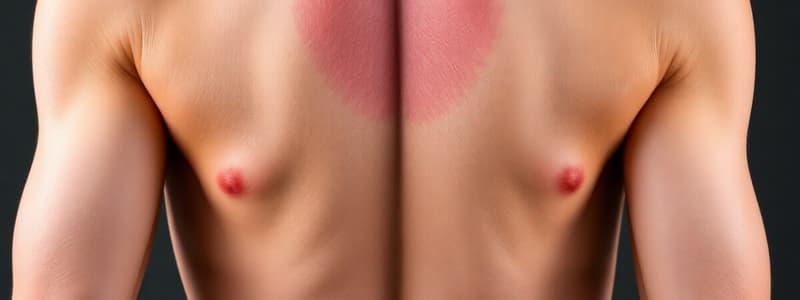Podcast
Questions and Answers
Which clinical feature is characteristic of dermatomyositis?
Which clinical feature is characteristic of dermatomyositis?
- Calf pseudohypertrophy
- Endomysial inflammation
- Heliotrope rash (correct)
- Muscle weakness improving with exertion
What distinguishes polymyositis from dermatomyositis histologically?
What distinguishes polymyositis from dermatomyositis histologically?
- Perimysial inflammation
- Heliotrope rash
- Endomysial inflammation with necrotic fibers (correct)
- Presence of Gottron papules
Which statement about X-linked muscular dystrophy is correct?
Which statement about X-linked muscular dystrophy is correct?
- It results in inflammation of skeletal muscles.
- It is more common in females than males.
- It is caused by mutations in the dystrophin gene. (correct)
- It exclusively affects distal muscles at onset.
How does myasthenia gravis typically manifest?
How does myasthenia gravis typically manifest?
Which laboratory finding is likely to be elevated in Duchenne muscular dystrophy?
Which laboratory finding is likely to be elevated in Duchenne muscular dystrophy?
What is the cause of Lambert-Eaton syndrome?
What is the cause of Lambert-Eaton syndrome?
What is a common association found in myasthenia gravis patients?
What is a common association found in myasthenia gravis patients?
What is the main underlying pathological change in Becker muscular dystrophy?
What is the main underlying pathological change in Becker muscular dystrophy?
Flashcards
Dermatomyositis
Dermatomyositis
A chronic inflammatory disease affecting both skin and skeletal muscle, often associated with cancer. Characterized by proximal muscle weakness, distinctive rashes on eyelids and joints, and elevated creatine kinase levels.
Polymyositis
Polymyositis
An inflammatory disorder primarily affecting skeletal muscles, causing muscle weakness, and characterized by endomysial inflammation with necrotic muscle fibers on biopsy. It resembles dermatomyositis but without skin involvement.
X-Linked Muscular Dystrophy
X-Linked Muscular Dystrophy
A group of genetic disorders causing progressive muscle degeneration and weakness due to defects in the dystrophin gene. This protein anchors the muscle cytoskeleton to the extracellular matrix, vital for muscle function.
Duchenne Muscular Dystrophy
Duchenne Muscular Dystrophy
Signup and view all the flashcards
Becker Muscular Dystrophy
Becker Muscular Dystrophy
Signup and view all the flashcards
Myasthenia Gravis
Myasthenia Gravis
Signup and view all the flashcards
Lambert-Eaton Syndrome
Lambert-Eaton Syndrome
Signup and view all the flashcards
Calf Pseudohypertrophy
Calf Pseudohypertrophy
Signup and view all the flashcards
Study Notes
DERMATOMYOSITIS
- An inflammatory disorder of skin and skeletal muscle
- Unknown cause; sometimes linked to cancers like gastric cancer
- Symptoms:
- Bilateral proximal muscle weakness (starts in the limbs)
- Skin rash (heliotrope rash on eyelids, malar rash, Gottron papules)
- Increased creatine kinase levels
- Positive antinuclear antibody (ANA) and anti-Jo-1 antibody
- Inflammatory cells (CD4+ T cells) with perifascicular atrophy in biopsies
- Treatment: Corticosteroids
POLYMYOSITIS
- Inflammatory disorder of skeletal muscle
- Similar clinical presentation to dermatomyositis, but without skin involvement
- Biopsy findings: Endomysial inflammation (CD8+ T cells), necrotic muscle fibers
X-LINKED MUSCULAR DYSTROPHY
- A degenerative condition causing muscle wasting
- Caused by defects in the dystrophin gene, crucial for anchoring muscle cytoskeleton
- Symptoms (Duchenne):
- Proximal muscle weakness from early childhood (around age 1)
- Progressive weakness involving distal muscles
- Calf pseudohypertrophy (enlarged calves)
- Elevated serum creatine kinase
- Death often from cardiac or respiratory failure
- Symptoms (Becker):
- Milder form due to mutated but not deleted dystrophin gene
- Symptoms can often come on later in childhood/young adulthood
MYASTHENIA GRAVIS
- Autoimmune disorder affecting the neuromuscular junction
- Antibodies target the postsynaptic acetylcholine receptor
- Symptoms:
- Muscle weakness that worsens with use, improves with rest (especially in the eyes, leading to ptosis and diplopia)
- Improved with anticholinesterase agents
- Associated with thymic abnormalities (hyperplasia or thymoma)
LAMBERT-EATON SYNDROME
- Autoimmune disorder affecting the neuromuscular junction
- Antibodies target presynaptic calcium channels
- Symptoms:
- Proximal muscle weakness that improves with use (different from typical myasthenia gravis)
- Symptoms are usually not affected by anticholinesterase agents
- Often associated with small cell lung cancer
SOFT TISSUE TUMORS
- Lipomas:
- Benign adipose tissue tumors
- Most common benign soft tissue tumor in adults
- Liposarcomas:
- Malignant adipose tissue tumors
- Most common malignant soft tissue tumor in adults
- Characterized by lipoblast cells
- Rhabdomyomas:
- Benign skeletal muscle tumors
- Associated with tuberous sclerosis (a genetic disorder)
- Rhabdomyosarcomas:
- Malignant skeletal muscle tumors
- Most common malignant soft tissue tumor in children
- Characterized by rhabdomyoblast cells
- Commonly located in head/neck or vaginal areas
Studying That Suits You
Use AI to generate personalized quizzes and flashcards to suit your learning preferences.
Related Documents
Description
This quiz covers key aspects of dermatomyositis, polymyositis, and x-linked muscular dystrophy, including symptoms, biopsy findings, and treatment options. Test your understanding of these inflammatory and degenerative muscle disorders and their clinical presentations.




